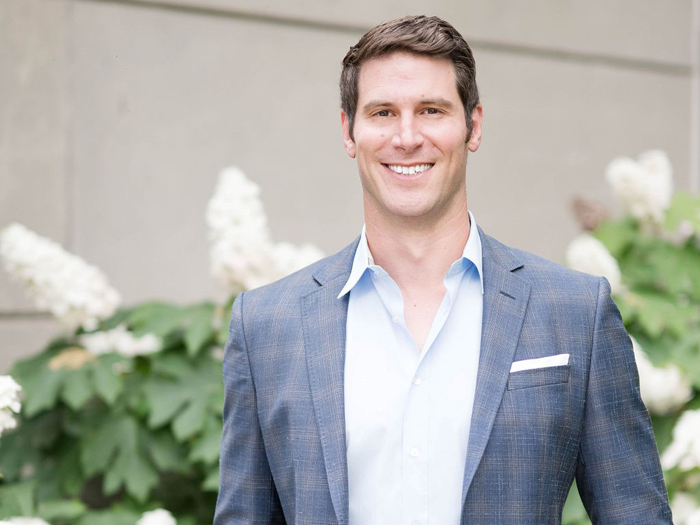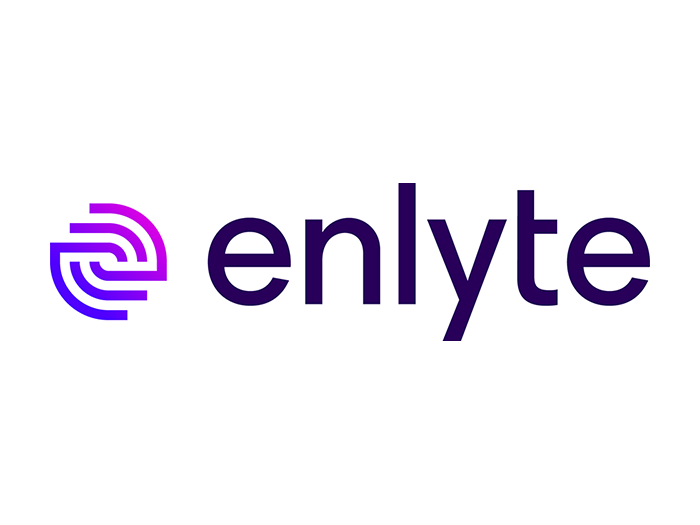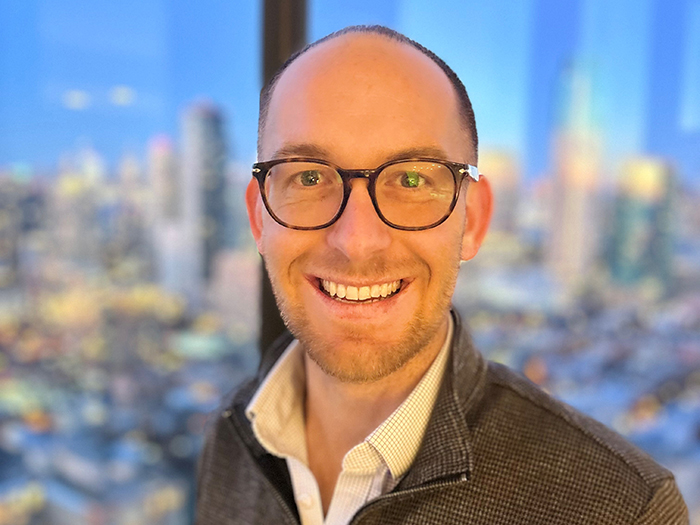Former NFL QB Sam Hollenbach Shares His Vision for Amp Health With R&I

Risk & Insurance recently caught up with Sam Hollenbach, a former quarterback for the Maryland Terrapins and the NFL’s Washington franchise, now the president and CEO of Amp Health.
What follows is a transcript of that discussion, edited for length and clarity.
Risk & Insurance: Thanks for your time today Sam. What have you learned from studying successful people across various fields, and how have you applied those lessons to your own career, particularly when it comes to taking risks and embracing challenges?
Sam Hollenbach: I’ve observed a consistent thread among successful people, whether in business, sports, or science: they put themselves in positions where they’re not sure how they will perform. They take on some risk and expose themselves to challenges, even when feeling uncertain about their abilities.
I’ve tried to embrace this mentality in my own career. It’s not always easy, especially as life becomes more complex with family responsibilities and financial obligations. However, I believe that putting yourself in front of a challenge without necessarily knowing the outcome is crucial for personal and professional growth.
As I’ve progressed in my career, I’ve continued to take on new responsibilities and roles that have pushed me out of my comfort zone. While it can be daunting, I’ve found that by taking calculated risks and facing challenges head-on, I’ve been able to develop new skills, gain valuable experiences, and ultimately advance in my field.
R&I: What motivated you to join Amp Health, and what have been your key focus areas during your first six months with the company?
SH: I was drawn to Amp Health’s mission and the opportunity to make a meaningful impact in the health care industry. Over the past six months, I’ve been focusing on a few key areas.
Firstly, I’ve been working to deeply understand our customers’ needs and pain points. This has involved extensive market research to engage directly with our clients to gather their insights and feedback.
Secondly, I’ve been collaborating closely with our product and engineering teams to refine our offerings based on these customer insights. We’ve been iterating on our solutions to ensure they effectively address the challenges our customers face.
Lastly, I’ve been building and strengthening relationships with key partners and stakeholders in the industry. By fostering these connections, we can better understand the broader healthcare landscape and identify opportunities for collaboration and growth.
It’s been an exciting and fulfilling six months, and I’m eager to continue driving impact in my role at Amp Health.
R&I: What market opportunities in the industrial workforce injury reduction space are most exciting to you and what possibilities do you see?
SH: The possibilities in the industrial workforce injury reduction space are immense. At Amp Health, we’re focused on reducing musculoskeletal injuries for industrial workforces. In the US alone, companies incur around $500 million per week in costs related to these injuries.
These costs include direct expenses for getting the employee back to work and indirect costs such as decreased production during the employee’s absence. Injuries also lead to other indirect costs like attrition and difficulty in recruiting and retaining employees, as people don’t want to be part of a work culture with a high injury rate.
There’s a huge total addressable market for reducing these injuries and improving both the health and happiness of employees and the well-being of employers. While we’re industry-agnostic and more concerned about the individual than the job, we currently see a lot of demand in construction, distribution and warehousing, and manufacturing and production.
However, physical labor and industrial workforces exist in other sectors of the economy, and we’re building products that can ultimately help those employees as well. We’re really excited about the vast opportunities as we get our business going.
R&I: What is Amp Health delivering in terms of predictive analytics to reduce workplace injuries?
SH: At Amp Health, we focus on proactively preventing workplace injuries through our A-M-P framework: Assess, Manage, and Prevent. Any injury can be explained by three factors: the person’s physical capabilities, the job tasks required, and the environment in which those tasks are conducted. We concentrate the person’s physical capabilities, and how they contribute to injuries.
In the Assess tier, we use computer vision through our mobile app to benchmark how the employee moves, capturing their symmetry, range of motion, and 25 other data points. This functional movement assessment provides a baseline of the employee’s movement capability.
The Manage tier functions like an EMR documentation system, but with a focus on early, pre-injury data. We call this proactive data, and we make it easy for our customers to collect proactive data related to how the employee is feeling, any onset pain or discomfort, allowing our customers to engage with the employee early, to avoid more serious injuries. Traditional EMR systems typically only document reactive data after an injury occurs.
The predictive analytics comes into view in our Prevent tier. The feature is still in development, but it works by analyzing all inputs, across both Assess and Manage features, and using machine learning to determine which factors contribute most to an injury. We then calculate the predictive power of all inputs, and determine the number of injuries we expect the customer to incur in a “do-nothing” scenario. We then take steps to help our customers understand which levers to turn to bend the injury curve.
One of the ways we do that is through our programming feature, which allows our customers to assign stretches and exercises designed to reduce injury risks observed at the individual or group level. This feature really complements our computer vision assessment, which illuminates musculoskeletal vulnerabilities, by giving customers a way to directly mitigate these risks, and keep the workforce moving safely.
R&I: What challenges do you see when looking at the business opportunities in front of you, either in the workforce, economy or competitive landscape?
SH: From a product perspective, one of the challenges we face is creating a product that is flexible enough to meet a broad variety of customer needs, while maintaining a high degree of polish and intuition. We’ve found that there is no silver bullet in workflow, documentation, or analytics that will serve the needs of our market; everybody does things a little different, as has different preferneces. So, we must create a highly adaptable system if we want to appeal to a broad set of customers.
For example, during employee engagements, or moments in which information about an employee is being recorded into our system, one tradeoff we consistently bump into is quality of data, versus friction of workflow. Some customers may want the easiest possible data acquisition experience, to optimize a low-friction workflow.
Other customers may want to spend more time on data recording, entering more data from the engagement, to build a stronger foundation for downstream analytics. Often times, however, the answer is “both” – and the onus is on us to deliver a customer experience that balances these conflicting needs in a delightful way. So, I’d describe at least one of our challenges in that way – our product must be pliable and polished across a wide range of customer operational models, while handling sometimes contradictory requirements with elegance.
R&I: How do you typically engage with potential clients, such as manufacturers, to implement your system into their operations? Do you partner with brokers or other entities in the insurance ecosystem?
SH: We are a startup, trying to grow our presence and awareness in this market, and so do a lot of outbound marketing to engage with potential clients. We are finding that we get pretty good interest from these efforts, but we are also finding that once we get a prospect into a meeting, it’s critical to learn exactly what their needs are, and center our conversation there. Our product offers a range of features, and we must be careful to align our messaging to the core needs of the customer – if we don’t, we’ll quickly lose the opportunity to advance the conversation.
Additional to our outbound strategy, we value relationships with brokers and see them as significant stakeholders, as they represent a channel to many types of customers. Brokers can make strong introductions due to their understanding of the unique business model and types of injury problems that their customers have. We want to make sure they understand our product well, so they can identify opportunities among potential customers with problems that we can uniquely help solve.
R&I: What kind of reaction do you typically see from workers and managers when you show them how they move and what their physical limitations are using your assessment technology?
SH: Right after an assessment is complete, engagement is at a high, and we definitely see high interest in understanding performance. It’s a great moment to help the employee understand what their movement deficiencies really mean, within the context of their job. One of the key features of our technology is that it’s all done on-edge, meaning assessments can be completed on a phone and results are available immediately without any cloud trip.
As soon as someone finishes the assessment, they can see their scores, vulnerabilities and movement impairments. In that moment, there’s often an “aha” reaction – they gain awareness of how their body is moving in a way they weren’t tuned into before. For example, if the assessment shows significant knee asymmetry during a squat, our customer can explain how this may impact the employee’s job, and provide guidance on how to move safely going forward. The employee can apply those insights right away, which we think can be a powerful risk mitigator in of itself.
Of course, beyond individual applications, there is immense value in aggregate data of hundreds or thousands of assessments collected over a period of time. If the data shows a concentration of risk in a specific subset of employees, for example, a certain shift at a specific location, this empowers our customers to investigate the physical rigors impacting those employees and take steps to mitigate their exposure.
R&I: What qualities do you look for in team members, especially considering Amp Health’s entrepreneurial environment and focus on AI and ML engineering?
SH: We seek individuals who are sharp, comfortable with an entrepreneurial environment, and have high aspirations. Working in a startup, trying to get from zero to one, requires a high degree of ownership, accountability, and internal motivation. It’s not the best place for someone who looks for approval or waits for someone else to give them what they need – we want people who are biased for action and can get the task done. There is a ton of room for impact and growth at Amp Health.
Beyond that, as a software company heavily involved in AI and ML throughout our stack, we are always on the lookout for strong engineering talent, particularly AI and ML engineers.
I’m really impressed with the progress our current team has made over the past six months. We’ve developed our product from scratch to where it is now, just entering the market with our version one. This has been no small effort by the team.
R&I: What regulatory developments or trends do you have your eye on that will impact how you approach businesses, particularly in areas like workers’ comp?
SH: We are certainly aware of the role OSHA plays in the documentation of injuries. While we want to focus on the proactive side of injury prevention, injuries do occur. When they do, there is a whole downstream set of actions that can happen depending on the situation.
Right now, we have to be aware of what constitutes an OSHA recordable, and what doesn’t – there are implications here that are highly important to our customers. But, to the point of the question, we stay pretty dialed in to OSHA – this is the main regulatory agency we must keep our eye on, and it’s pretty incredible how powerful they are – they can introduce a small change that has wide-sweeping effects throughout our industry.
That said, we try to really focus upstream of actual injuries, and we believe industrial employers will continue to want healthier and happier workforces, regardless of the regulatory landscape. That is what anchors our approach and is a big reason why we are so confident about the future.
R&I: What are your considerations and thoughts around protecting the health data you’re collecting, especially given the heightened concerns around cybersecurity today?
SH: Data privacy is paramount for AMP Health and we are in the process of attaining HIPAA and SOC 2 compliance. However, our commitment goes beyond just meeting compliance checkmarks.
We integrate data privacy considerations upstream as we develop new features. For example, our functional movement assessment runs on the edge, so that we never have to send employee video data to the cloud.
We also limit exposure to PHI data within the company. A small group has access to PHI, while our engineers work with anonymized data to build machine learning models that help develop our understanding injury risk.
When ingesting third-party workforce health data to feed our machine learning models, we prefer to receive it pre-anonymized to reduce our cyber risk upfront. Data privacy is a high priority that we take very seriously, both externally and internally at AMP Health.
R&I: How does Amp Health utilize historical loss data and injury data from specific industries within its current technology models? Is there any consideration for employer loss data?
SH: We believe in collecting as much data as possible. Bringing in historical loss data allows us to demonstrate the efficacy of certain interventions through our analytics dashboard.
One feature we believe will be particularly impactful is our programming feature, which provides employees with exercises and stretches designed to reduce their injury risk. By incorporating historical injury or loss data into our analytics dashboard, our customers can see just how effective their “stretch and flex” program actually was from a metric that might matter more than any other – loss totals.
We can ingest all types of loss data, but our primary focus is on acquiring injury data, as this is where we anticipate the most meaningful outcomes and insights.
R&I: How does Amp Health leverage aggregated, anonymized data from different customers to improve risk modeling and provide more accurate outputs over time?
SH: We collect anonymized data from our customers and use it in an aggregate sense to better understand how injuries occur. With big data, more is more – we want as much data as we can get. We have machine learning models for data analysis, and plan to use these to develop powerful predictive analytics. Building a sufficiently large dataset is a function of time though, so the accuracy of our models will improve as we collect more data. We are proactively building our tech stack to leverage machine learning models that can process big data.
With an emphasis on data collection, we are positioning ourselves to offer more actionable and accurate outputs, risk models, and other insights as we continue to grow.
R&I: How does AMP Health’s background in sports influence its approach to supporting industrial workers’ health and performance?
SH: We consider the employees we focus on as industrial athletes. Our company was born in sport, building products for athletes before pivoting to industrial applications. This connection to sports was one of the reasons I was drawn to the company, due to my background in sports and passion for health tech.
My sport was football, and in football, there’s a concept of being available for your team, both for practice and games. It takes an enormous amount of work – training, stretching, physical therapy, nutrition, and more, just to make it onto the field. We bring that mentality to the industrial workforce. While the work may differ, industrial athletes also need to put in effort to stay healthy and available for their team over the years. There’s work they need to do before even getting to the production floor to do their job without injury and contribute to their team.
Whether it’s an NFL athlete or a welder on a construction site, the goal is the same: to be fit, healthy, and able to do your job day after day to earn a living and provide for your family. This sports-inspired approach to supporting industrial athletes differentiates us and is core to the technology we’re building. &










